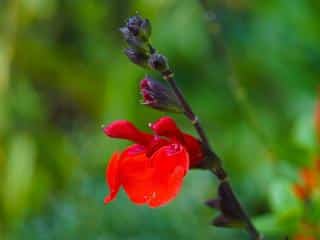

Everything in it is subtle: small delicate flowers, light fragrance, rounded leaves, airy bush bearing, and it brings poetry to the mind when added to the bouquets you can prepare from it: grahamii sage will stay with you until the first frosts of the season.
Grahamii sage is a perennial native to Mexico that won’t help you much in the kitchen, but in the garden it is a precious plant that will keep you company with its joyful colors, even when cold winter days are nigh.
Ornamental and quite charming, it is fine standing in the middle of the lawn or flower bed or along a walkway’s edge.
Its leaves emit a most delicate perfume when they’re ruffled, too.
Grahamii sage is purchased in pots in horticulture stores and can be put to the ground in spring or fall, preferably in a corner of the garden that is sheltered from strong wind while still getting a good dose of sun. To succeed in planting without any problems, soak the clump and plant it without burying it too deep, at ground level, in neutral, well drained soil. The soil must never stay too wet, especially in winter. If needed, add sand and gravel to ensure drainage.
It will drape itself with hundreds of vermilion red flowers spreading an agreeable odor until it freezes again. Grahamii sage resists drought, but you must protect it nonetheless at its base in winter. In mild climates, its very delicate flowers grouped in panicles can last deep into the cold season. The plant can grow with a lot of enthusiasm, reaching heights of 40 inches (1.2 meters) easily. Amending the soil with compost or organic fertilizer in spring and fall will embellish it even more.

Propagate it at will, it’s very easy. You can prepare cuttings over the summer (August), but if you let nature do its part, it’s even easier! Ridge up some earth around the base. The base of each stem will sprout roots. You can them detach them from the mother plant and settle them elsewhere. It’s always good to have a few stems where you’ve stacked soil up around at hand, because thanks to its abundant persistent flowering, all your friends will ask you for a shoot!
It’s also a potent pest repellent, driving large white away and protecting your vegetables!